Welcome to CamundaCon!
We hope you’re as excited as we are for CamundaCon 2023, which starts today! We’ll be bringing you the latest updates from the event live on this blog post as they’re happening. Be sure to check back often as we’ll be updating this post throughout the day.
We’ve officially sold out the venue, but if you couldn’t join us in person in New York City, you can still catch all the sessions online for free! Just register at the link below, check out the agenda and make sure you don’t miss a thing. We’ll see you there, whether online or in person!
Update: Did you miss CamundaCon, or just want to check out the sessions you couldn’t catch live? All replays are now available at the link below!
Here with us before the opening keynote? Here’s a sneak peak behind the curtain of things getting set up!

Ok, it’s almost 9am ET on 9/27, and we’re about to get started!

Welcome!
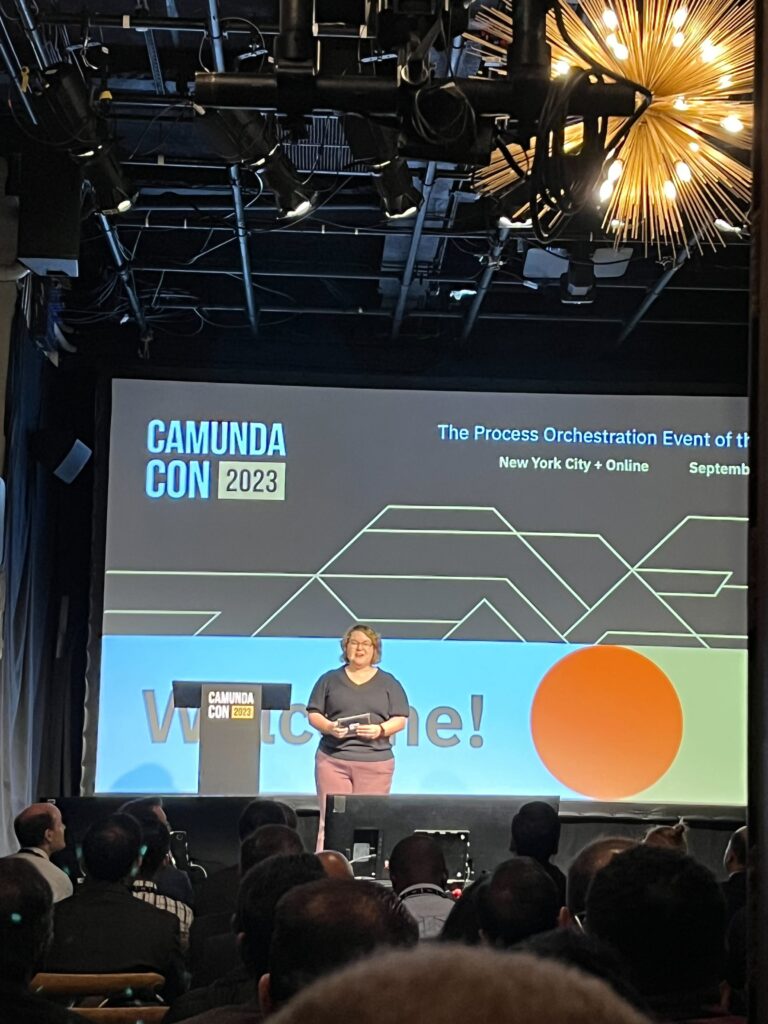
Camunda’s Amy Johnston welcomed everyone to CamundaCon 2023, the first hybrid CamundaCon in the US! After a brief explanation of the Selfie Screen (tag your selfies with #camundacon and #selfie to join!), how to navigate both tracks and highlights of key speakers along with our AMA and sponsor booths, she welcomed Camunda CEO Jakob Freund to the stage.
Opening Keynote by Jakob Freund
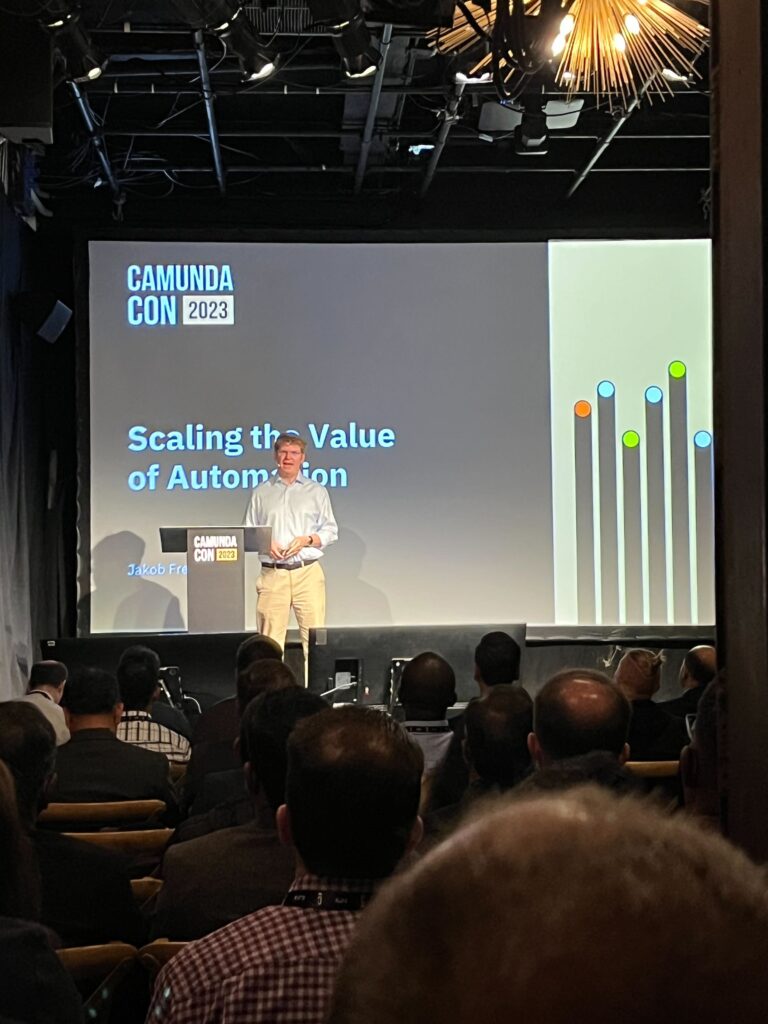
Jakob started off with a quick overview of the history of Camunda in the US, starting with an initial deal ten years ago and growing to 163 customers to date in North America alone. He spoke of how exciting it is to be here with hundreds of attendees and everyone online to learn the experiences people are having with Camunda. The diverse range of speakers from banking to healthcare to scientific research is really amazing.
Next he addressed the “why” of automation? Jakob noted that whenever he speaks to leaders in organizations, they always want to “automate the heck” out of their business. Many tools like RPA have helped add some automation around the periphery, but core business processes have always been kept out of those automation tools by one word – complexity. True end-to-end processes need to access multiple systems and endpoints, and that is complicated. The way to manage this complexity, as Camunda has been saying and folks like Gartner have agreed, is process orchestration.
Where organizations are with process orchestration is not binary – it’s not like you’re either doing it completely or not at all. Jakob talked about the value of developing process orchestration maturity, which is a concept Camunda has developed by learning from its over 500 customers and over 5,000 tech and industry business use cases that Camunda is solving. It’s a way to get more and more value out of process orchestration.
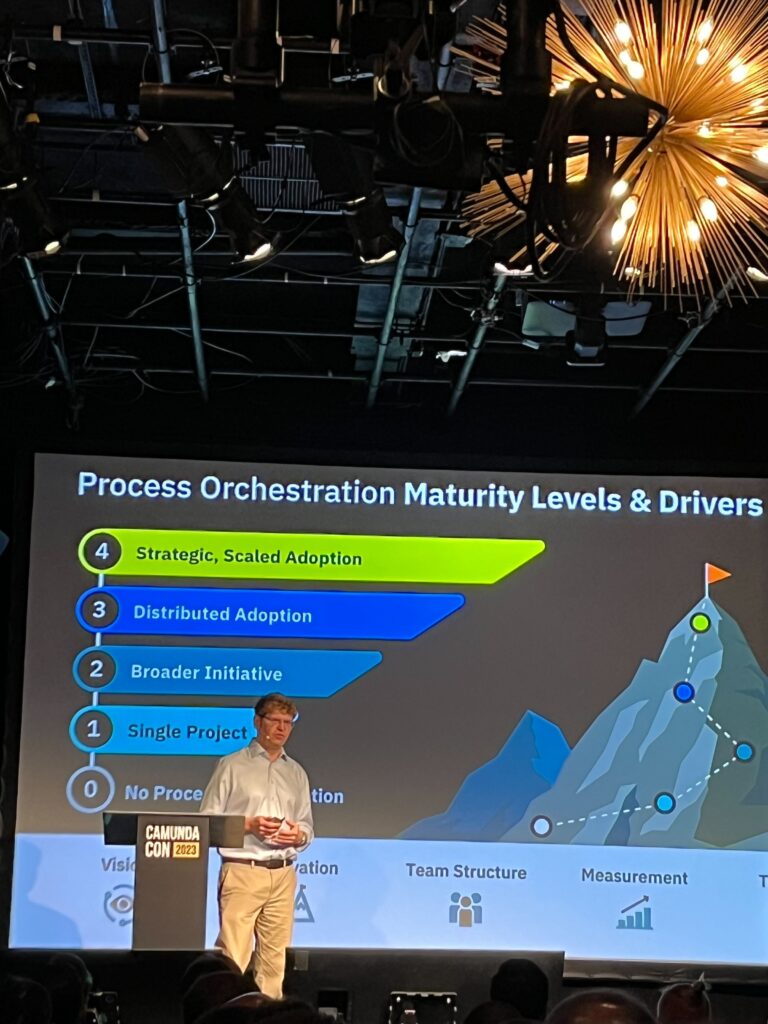
Then he moved onto a real example of process orchestration in action. Since we’re in New York City, he started with an example of – what else – a financial services company. He laid out key initiatives and use cases along with challenges they face. He went through the stories of companies like Desjardins, Truist bank, NatWest and others. He also spoke to the innovations in Camunda around open standards, open architecture and cloud-native architecture. He emphasized Camunda’s solution acceleration and how Camunda plans to implement low-code and AI in ways that truly help teams create solutions quickly and don’t actually slow them down. For example, Camunda’s AI-based form generator.

Jakob next debuted a brand new Connectors Marketplace – another way to get going faster – and other new enhancements both already here and on the roadmap for 2024 to make it easier to scale up process orchestration across the enterprise. It’s a pretty exciting present and future – be sure to check out the full recording to hear more about everything that’s going on.
Leveling Up Business Process Management at the U.S Patent and Trademark Office
Next I headed up to the Rooftop Stage, which has a gorgeous view of the Manhattan skyline, to hear about how the Booz Allen Hamilton helped the US Patent and Trademark Office up their game. This team is used to working with the government to speed up processes – last year they spoke at CamundaCon on their work with the Department of Veteran’s Affairs. Daniel Regan of Booz Allen kicked this off by talking about Camunda’s own trademark in the US.
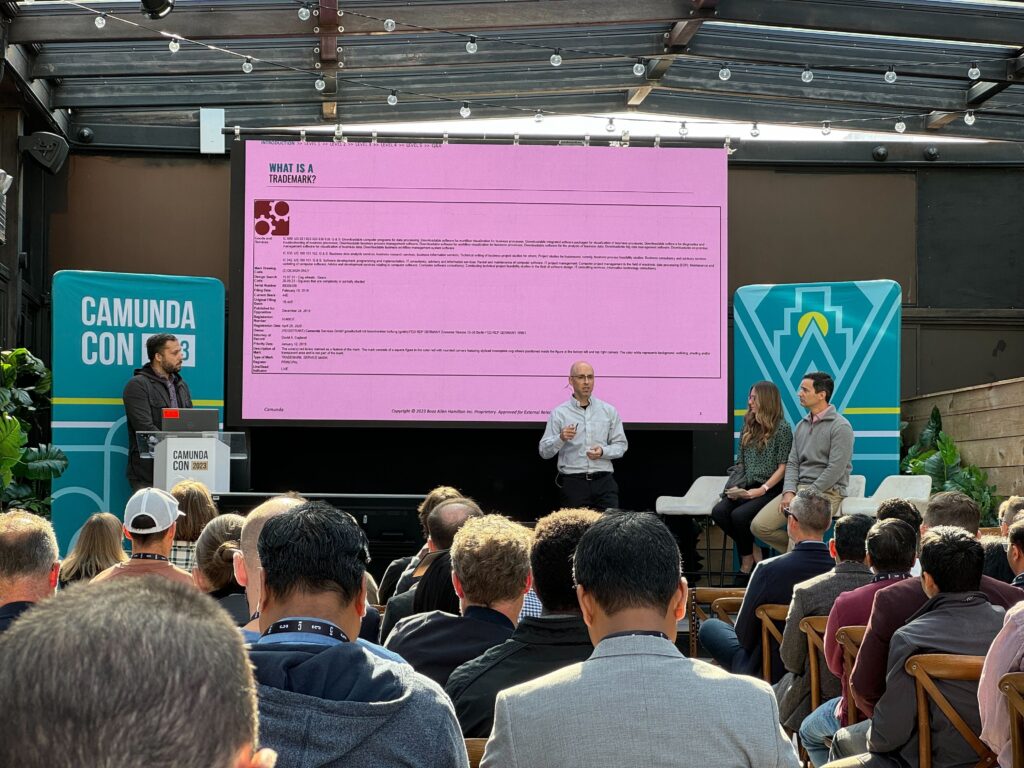
Holly Giles then spoke to the value of BPMN in helping technical and non-technical stakeholders communicate to each other, and how effective it can be to visualize the entire end-to-end process in one place. One example was a 20-day waiting period for an event that was originally due to the time it took to typeset a newspaper – obviously this no longer applies, but it hadn’t been noticed and questioned until the BPMN model made it more apparent.
Matt Price stepped up next to talk about the use of DMN to migrate away from a legacy COBOL-based mainframe validation system – a huge time saver. Jon Becker was then ready to show us a demo of how they implement it all to make “COBOL a No-bol” – a pun he shared to expected groans from the audience. It was a great demonstration of how a legacy system can be upgraded to a modern one, even within the confines of a highly regulated environment.
The Konnektor Kitchen
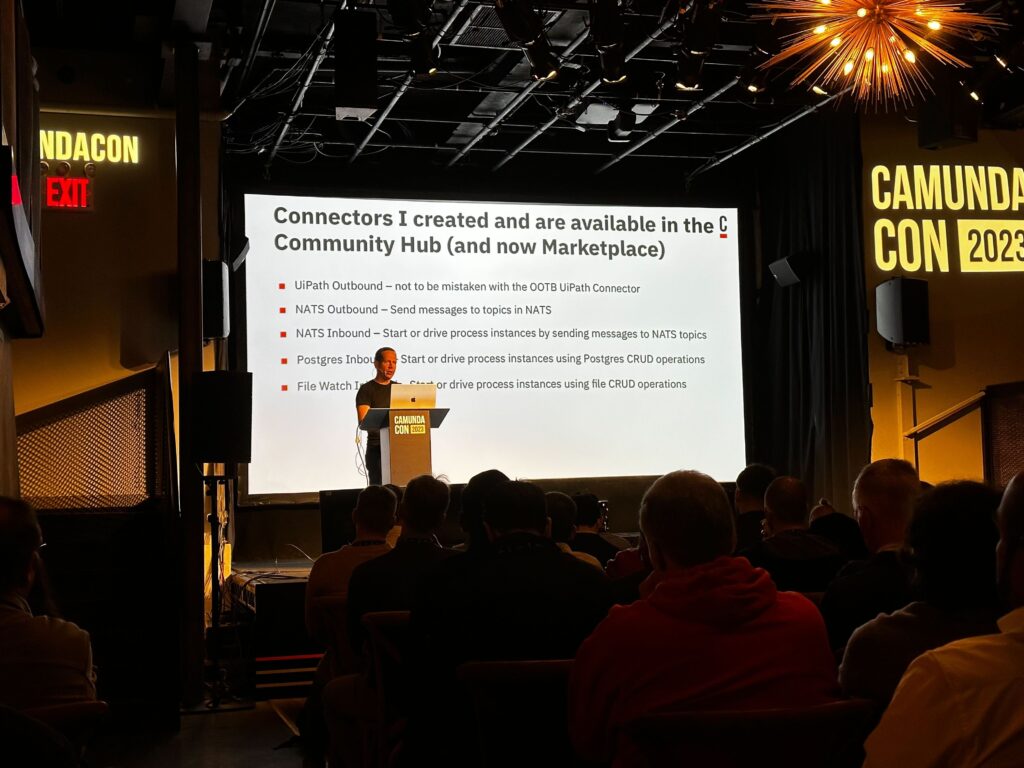
Meanwhile, downstairs in the Main Stage, Joe Pappas of Camunda was sharing his work in what he calls the Konnektor Kitchen – he has done some impressive work creating Connectors and sharing them in the new Marketplace. Be sure to watch the recording to see what he has to share and learn more about how you can contribute too.
Behind the Scenes – Online

For our online attendees, we have some special programming. This break featured behind the scenes interviews with leaders of our community, including Bernd Reuker, Camunda co-founder and Chief Technologist, Mary Thengvall, Camunda’s Director of Developer Relations, and Maria Alcantra, Camunda Community manager.
Kiwi.com’s Epic Journey From Legacy System to Camunda
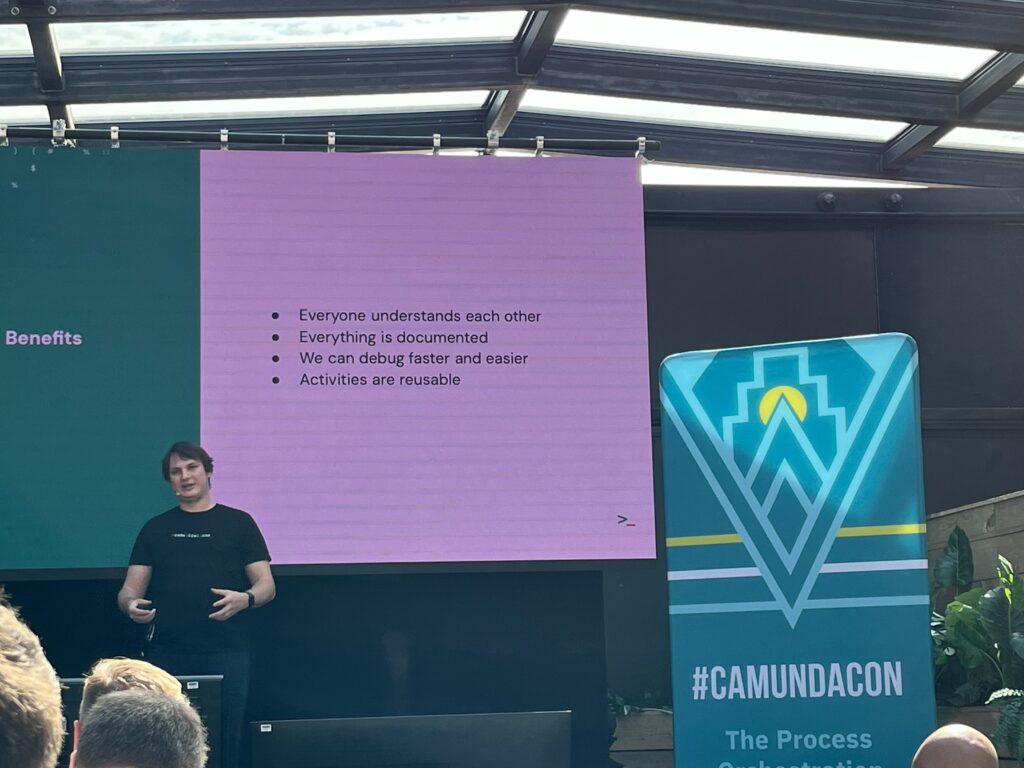
On the Rooftop Stage, Milan Lesnek then took us on a tour of Kiwi.com, a flight booking site, and their journey to a modern Camunda system. When Kiwi.com started out, a fairly simple BPMN diagram covered their needs, but as their volume grew to tens of thousands of flights booked daily, their diagram became an untenable “spaghetti monster.” It still worked, but there were over 26,000 possible scenarios, making observability nearly impossible and making it very complicated to continue to add new features.
Working with Camunda, they were able to improve their use of BPMN, refactor their code and make the end-to-end process more testable and observable. Now they have 54,000 daily processes and have had no errors whatsoever in months (outside of one developer typo that Milan very much regrets). He shared how Camunda has made it easier for everyone to understand each other, the strength of the documentation, ease of debugging and reusability.
You can read more about Kiwi.com’s journey here.
How We Cut Our Change Lead Time for BPA in Half With BDD

Back in the Main Stage, Laurenz Harnischmacher and Stefan Post from Zurich Group spoke about using Behavior Driven Development to drive their end-to-end process automation. If you’re curious about whether this framework might work for you or how to implement it, this is a great session to tune into and learn by watching exactly how someone else did it.
Selfie Time

Have you uploaded your selfie yet using #camundacon and #selfie? Post your picture and you may pop up too on our Selfie Screen!
Next Stop: Advanced Automation – Fast-Tracking Process Orchestration
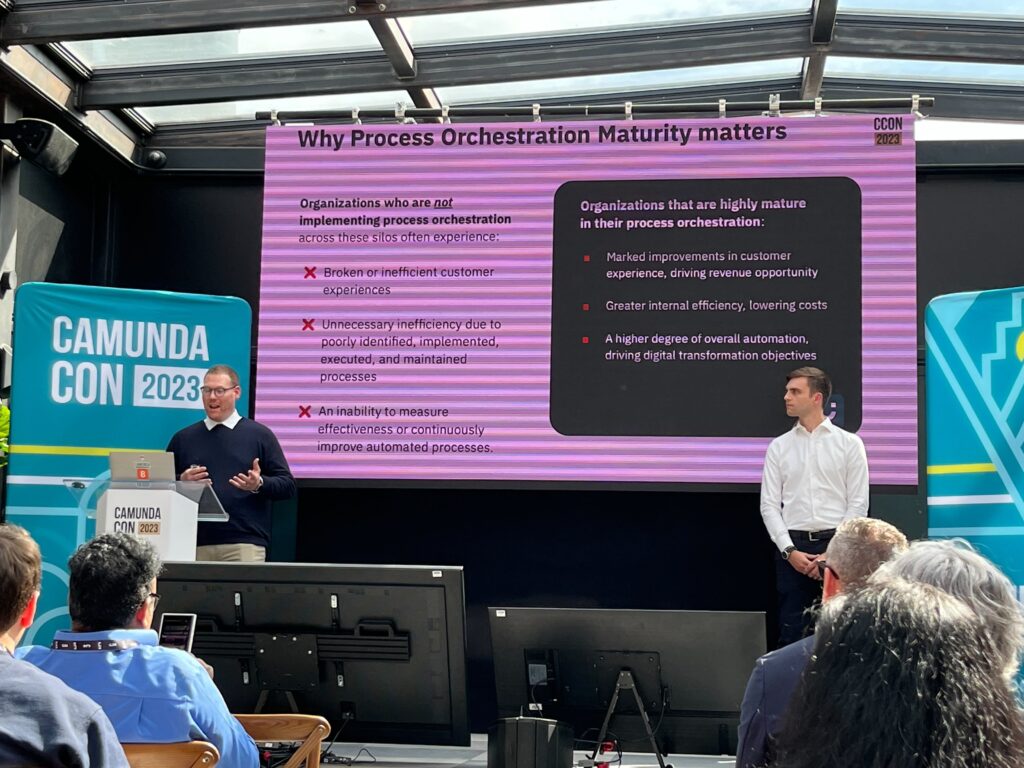
Continuing on the roof, Daniel Levy and Felix Mueller spoke about the keys to getting process orchestration up and running faster – and why it’s so important. Daniel walked us through an example of an insurance company starting at level 0 of the process orchestration maturity model that Jakob talked about earlier. At this stage, neither employees or customers are happy and the business is suffering. How would they kick off an individual project – say around claims automation – and get to level 1?
Felix jumped directly into a demo to show how rapidly a BPMN model could be built to handle automating claims. He showed how you can manage the process in Operate and use TaskList to enter data that the claim needs – it was pretty slick to see the automation using RPA, SendGrid and more working in real-time, including how to quickly fix errors if they pop up and using Play mode. There was a wow moment when Felix used the new AI form generator to quickly create a claims form for the process. Some steps were still at least partially manual, but this is level 1, and you can already see the time being saved.
Dan and Felix showed how automation can be expanded and enhanced throughout an organization as you increase your process orchestration maturity. Watch this one to see how they build up from a fairly straightforward process, to iterating and enhancing it via Optimize, to creating a Center of Excellence and reusing Connectors and much more to get to level 2 and then level 3. After that there is a roadmap to how you can ascend to the peak of the mountain and reach level 4. It was cool to see how quickly you can get started and how far you can go with process orchestration.
6 Years of Camunda at NatWest: Impacts, Changes, Learnings and the Future

At the same time, on the Main Stage leaders from NatWest, a leading UK bank, were telling their story about how they have transformed processes at NatWest over six years while pioneering new tactics using Camunda. Check this one out – it’s a great chance to learn from their experiences and see what’s possible.
Lunch and Expo Booths (and Bite-Sized Learning online)
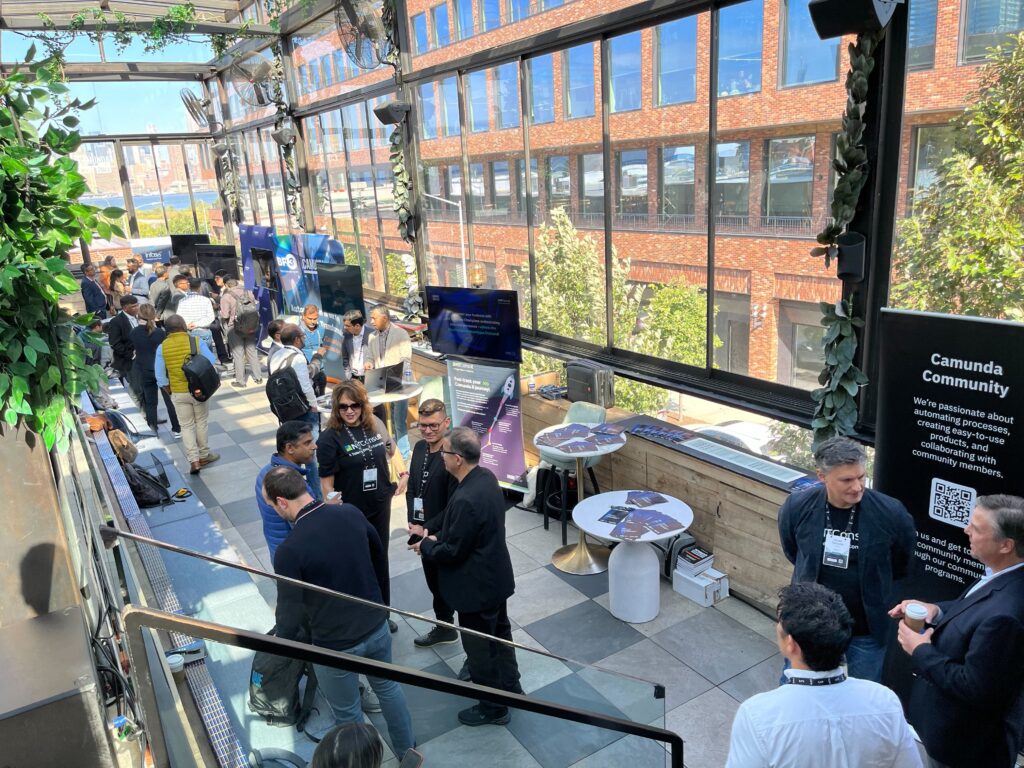
After this, it was time for lunch! The expo booths have been open all day of course, but this is a great time to check them out and have a good conversation with Camundi or partners. At the same time, our online attendees get to enjoy the some bite sized learning and networking opportunities.
Camunda for Common Good: Automating the Application and Onboarding Processes for Students, Mentors and Volunteers

On the Main Stage, Danny DeJesus introduced us to Urban Tech Hero, an organization he founded dedicated to supporting underserved youth by giving them technical education and “the superpower of tech.” He shared the values that guide their organization and their vision to transform economically disadvantaged communities to technologically empowered ones. Partnering with Camunda and the Camunda for Common Good program, they are able to reimagine their onboarding process.
Adriel Henderson explained that an onboarding process, which was supposedly three simple steps, really was far more complex with many possible scenarios – that’s what you see above. The complexity resulted in delays for their students. Urban Tech Hero needed to get their students onboarded as quickly and clearly as possible, and that’s where Camunda came in.
Jono Patridge came next to demonstrate the solution he implemented with Camunda. He was able to design a solution using a relatively simple main process with several subprocesses underlying it, accounting for edge cases and errors and making the end-to-end process easier to visualize, understand and increasingly automate. Danny estimated that onboarding each student used to take 2-3 hours, but now it takes 15-30 minutes.
Danny noted that Jono came on board, learned Camunda from scratch via the Academy and Forum and orchestrated everything in just a few months – to Danny, this is a prime example of what Urban Tech Hero is all about. He closed with an inspiring pitch for all of us to be tech heroes.
Revolutionizing FinTech: Fully Automated Instant Loan Approval Processes Orchestrated With Camunda

Technology changes as humans evolves and changes how we live. That’s how Rajesh Kumar Dharmalingam of Funding Societies opened his talk, explaining that technology has fundamentally changed financial services as well. Rather than a select few being able to talk to bank tellers, the industry has opened up to people all over the world through devices such as smartphones. But a key challenge remains around loan approvals. How can this be made quick, accessible and agile?
Rajesh detailed the complexity of a typical loan approval process and then demonstrated how BPMN process models in Camunda can handle this complexity and accelerate the overall process. Both an automated approval process and manual approval process were modeled (as each might be required for different kinds of loans), and a result each is easier to understand, track and implement. Rajesh also spoke highly of the flexibility involved in separating the business logic from the code, making is far quicker to change rules and eligibility requirements whenever needed.
Overall, the approval process was shortened to just a few minutes – essentially instantly. This delivers a tremendous customer experience and is a key competitive advantage for banks that provide it. This was a compelling and fun talk about the difference process orchestration can have on a truly complex process that is critical to the health of an organization. Rajesh shared lessons he has learned and then closed as he began, thinking about the power of technology to change the lives of people for the better.
ICYMI: On the roof
While I was attending these last two sessions in the Main Stage, there were some fantastic sessions up on the Roof Stage. Walmart gave a great presentation on “Process Modelling of Smart Contracts,” detailing how they included blockchain-based contracts into their end-to-end BPMN process modeling. Cisco also gave a talk, “Transforming Cisco’s XaaS Business Into a Scalable and Simplified Process Automation Architecture,” detailing how they used Camunda’s process automation engine to move away from a purpose-built workflow engine and accelerate their processes, including how they use Operate and Optimize to monitor and continuously improve. Don’t miss them!
Camunda Community Break & Bite Sized Learning
For our in-person attendees, we have community members meeting up on the roof. It’s a great time to meet community leaders or just stretch your legs as you get ready for the rest of the day. For our online attendees, we’ve got more bite-sized learnings for you as well, so be sure to stick around for it.
Scaling Automation: Lessons Learned From Provinzial’s Center of Excellence

André Wickenhöfer and Björn Brinkmann of Provinzial joined Leon Strauch from Camunda on the Main Stage to talk about the value of a Center of Excellence (CoE). Leon put the question bluntly: To CoE or not to CoE? Leon shared that some organizations are wary of a CoE, worrying that it might slow them down – but the answer is you have to provide the right CoE for your organization, and done right will help tremendously in achieving a higher level of process orchestration maturity. One key choice is to decide between a more traditional centralized CoE, or a decentralized/federated CoE.
Provinzial started with Camunda in 2013 with a few goals: helping business users focus on value-creation, building flexible end-to-end processes, and closing the gap between IT and business. After building an initial project, they wanted to scale, and they opted to do this through a CoE focused on enablement and communication, producing blog posts, trainings and more. As they scaled further, they began to guide decentralized teams to build their own end-to-end processes. Over time, these teams were given more and more autonomy as the scale increased, and the job of the CoE is to continue to enable these teams and add new capabilities through improvements like evaluating Camunda’s SaaS-based offerings.
This was a fascinating talk by experienced leaders who grew a CoE from a small centralized operation to a decentralized one that now enables many teams, allowing Provinzial to scale up their automation to great heights (14 million decisions per month) faster than they ever could with a centralized methodology. Key to this was building a community and allowing more autonomy to be able to handle the increased complexity that comes with scaling to various teams and use cases.
One more on the roof: Building Bridges in OSS
I was still at the Main Stage, but the last session of the day on the roof was by Proximus. They used Camunda to transform their open source software IT architecture into a cloud-based, stack of TMF-standardized services. See how they did it, why they chose Camunda and what they’re planning next.
Camunda at the Heart of CERN’s Electronic Document Handling System

We all joined back together on the Main Stage to hear from CERN, one of the largest and best-known research laboratories with nine particle accelerators. Over 17,500 people work there and they process over a petabyte of data daily. In short, they have a lot going on. With the size of the organization, they’ve long known they needed to optimize and digitalize their processes, and they have been doing so since 1992.
Dmitry Kekelidze of CERN highlighted the difference by telling a story of an institute he was at where he needed to complete a lengthy paper form to access the office outside of the usual hours, which had to be manually approved. When he joined CERN, he was able to make the request digitally, and it was assigned within minutes and he got a reply within an hour and a half (unfortunately, his request was rejected, but at least it was quick!). The number one process requested at CERN, as perhaps you might expect, is a leave request – there have been 2 million such requests since implementation in 1992.
CERN migrated from Activiti to Camunda in 2021. Camunda was originally a fork of Activiti, which is one reason why 99% of code and all BPMN diagrams could be moved with minimal changes. Throw in the very active product development, superior performance and excellent support and CERN knew Camunda was the right choice. The migration went well overall and at this point is almost complete.
In the end, Camunda has provided them with a very fast and stable engine for process orchestration that is well-documented and runs on a modern tech stack – exactly what they needed. Really cool to see Camunda in use for such a large, complex and unique organization!
Spotlight Conversation: Implementing Best of Breed Automation in Financial Services
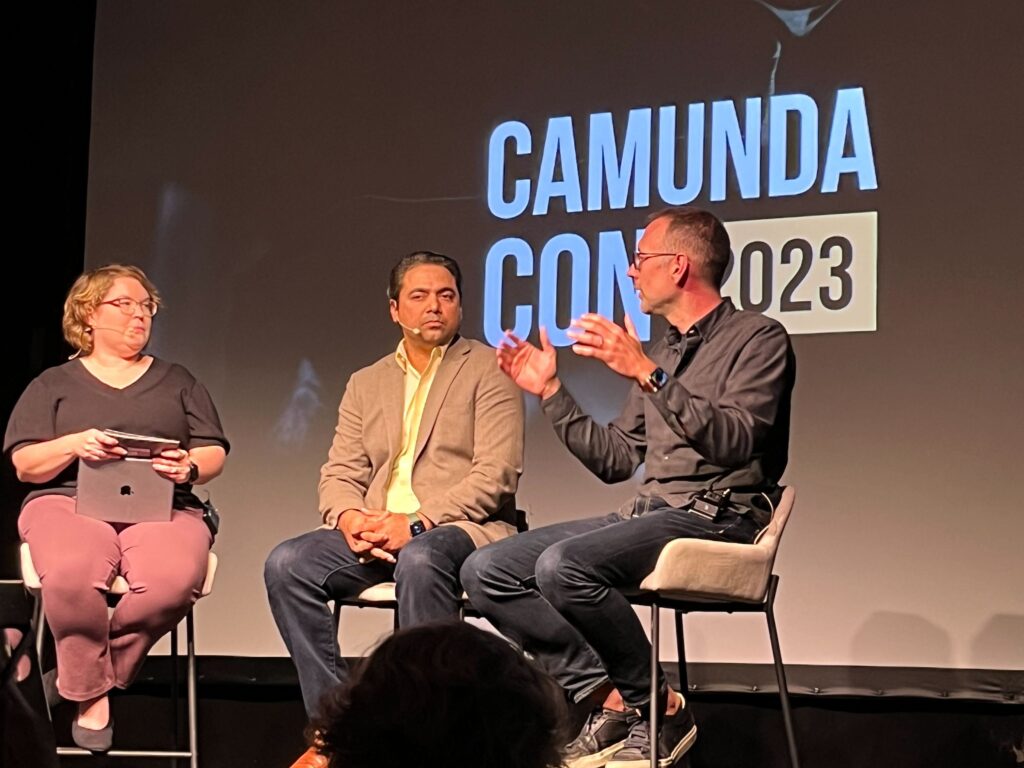
Next up on the main stage, Deepak Tiwari (Managing Director at EY) and Daniel Meyer (CTO at Camunda) joined moderator Amy Johnston (Principle Product Marketer at Camunda) for an engaging conversation on the evolution of automation in the financial services industry.
The conversation centered around the evolution of automation solutions, with less of a focus on the “one stop shop” and a using a larger range of best-of-breed tools to achieve automation. Deepak compared it to vendors who used to think that they would buy a new car and customize it a bit – but now they can build their own car, in their own garage, allowing for a lot more control.
Financial services are increasingly dependent on the technology they run, and Daniel pointed out that they are increasingly becoming software companies. In the past IT was more of a cost center, just something to run the business – but now it is a growth engine, a potential differentiator that can drive real competitive advantage.
There were many topics discussed – process orchestration maturity, CoE, being process-first, low-code, IT modernization, AI, the future of financial services automation and more – too much to recap here! Be sure to watch the recording after to hear everything Daniel and Deepak had to say.
Wrap up & Fireside Chat

We conclude Day 1 of #CamundaCon 23 with one last discussion between Jakob and Amy. The conversation centered around the Center of Excellence, and especially the nuances of it that Leon brought up earlier in the day with Provinzial. Amy expressed amazement at the growth of the role, which was not that common just two years ago, but now is so central to automation. Jakob pointed out that the role can be pivotal, that often at the C-level there is not as thorough an understanding of automation and that CoE leaders can be the experts at their company (very important, not to mention a good career move).
Amy and Jakob spoke about the future of AI as well. Jakob spoke about the potential value of an AI co-pilot to help you get stuff done faster – but that we are not yet at the point where it will do complex things for you. AI is and will continue to be useful for automation, but there’s “always something to it” when the hype claims a single technology will solve everything, and that shouldn’t be the expectation.
Camunda is a global, remote-only company, and Amy asked Jakob about how that journey has been for Camunda. Jakob says that trying to be both an office-centric and remote-centric company can be a struggle – it’s hard to “have your cake and eat it too.” If you want to be a global and distributed company, there’s no way around a remote setup. There are a lot of angles to consider when making the choice and Jakob called it in some ways second only to providing process orchestration to the world in terms of interesting journeys for Camunda.
Plenty of other topics were touched on as well. Be sure to check out the replay to hear the full conversation.
Aftershow and networking
And that’s it for day 1! The aftershow and networking are about to begin for those who are here in New York. For everyone, recordings of all sessions will be available as soon as next week. Thanks for joining us, either in person, online or right here on this post, and look out for another liveblog post tomorrow!
Update: Did you miss CamundaCon, or just want to check out the sessions you couldn’t catch live? All replays are now available at the link below!


Start the discussion at forum.camunda.io